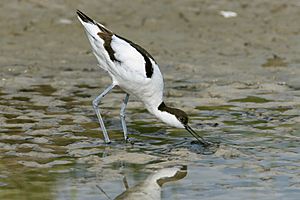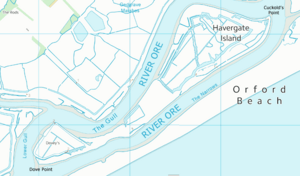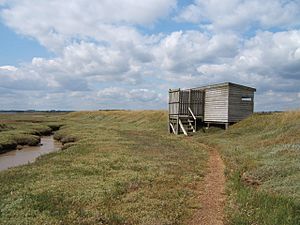Havergate Island facts for kids
Havergate Island is the only island in Suffolk, England. It is located where the River Ore and the Butley River meet, close to the village of Orford. This island is a marshy nature reserve looked after by the Royal Society for the Protection of Birds (RSPB). It is famous for its large numbers of avocets and terns.
Havergate Island is a very important part of the Alde-Ore Estuary. An estuary is where a river meets the sea. Because of its special nature, the island has many different types of protection. It is a national nature reserve, a Site of Special Scientific Interest (SSSI), and a Special Protection Area (SPA). It is also part of the Suffolk Coast and Heaths Area of Outstanding Natural Beauty (AONB).
The island is about 3.2 kilometres (2.0 mi) long and 0.8 kilometres (0.50 mi) wide at its widest point. It covers about 1.08 square kilometres (0.42 sq mi). It sits within the Alde and Ore estuary. A long, narrow shingle landform called Orford Ness protects it from the North Sea. The island is surrounded by river channels that locals call The Gull, Lower Gull, and The Narrows.
Contents
Wildlife on Havergate Island
Havergate Island has six large salt water lagoons, which are like shallow lakes, covering 60 hectares. These lagoons are surrounded by earthen banks. There are also 40 hectares of salt marsh and four hectares of vegetated shingle, which is a beach covered in plants. The island also has areas of grazing marsh and mud flats. All these different areas create important homes for rare gulls, wading birds, and many other animals.

Birds
The island is a vital place for many migratory birds that visit during different seasons. It is also home to many birds that live there all year round. Havergate Island has the biggest group of pied avocets breeding in the UK. It is also the only place in Suffolk where Sandwich terns breed.
Other birds you might see on the island include oystercatchers, redshanks, ringed plovers, golden plover, dunlin, greenshank, and turnstones. You can also spot wigeon, pintail, and wheatears. The lagoons and marshes are perfect spots for birds to rest and find food.
Birds of prey like short-eared owls and marsh harriers are often seen hunting over the island.
Other Animals
Besides birds, the island is home to small mammals like mice and voles. There is also a healthy group of about 29 hares. Common seals have been seen swimming in the river around the island.
Many types of butterflies also live here. These include skippers, small coppers, walls, meadow browns, and gatekeepers.
Protecting Havergate Island
Special Protected Status
Havergate Island is a national nature reserve. It is managed by the RSPB. The nearby Orford Ness site, managed by the National Trust, also has this special status.
The island is part of many other important protected areas. These include the Alde-Ore Estuary Site of Special Scientific Interest (SSSI). It is also part of the Alde, Ore & Butley Estuaries Special Area of Conservation (SAC) and a Special Protection Area (SPA). It is listed as a Ramsar Site, which means it's a wetland of international importance. Finally, it is part of the Suffolk Coast and Heaths Area of Outstanding Natural Beauty (AONB).
How the Island is Managed
The Royal Society for the Protection of Birds (RSPB) owns and manages Havergate Island. They actively work to improve the habitats, especially the lagoons, for the birds that breed and spend winter there.
This work includes controlling water levels and how salty the water is. They also improve places where birds can breed and create more areas for them to find food. They even make deep water spots for small invertebrates (like insects and worms) to live. The RSPB also controls animals that might threaten bird nests, such as foxes and gulls. Volunteers help a lot with this work, including counting birds.
Future Challenges
Havergate Island is very low-lying. This means that rising sea levels are a big threat to the island in the future. The RSPB knows this and has already worked to make the river wall stronger.
However, long-term plans accept that parts of the island might eventually be lost to the sea. This is part of a plan called "managed retreat". This means allowing the land to change naturally into salt marsh. To help with this, the RSPB plans to create new habitats in other, safer areas nearby. One important project is to expand Boyton Marsh to replace key habitats that might be lost on Havergate.
Visiting Havergate Island
You can only get to Havergate Island and its nature reserve by boat from Orford quay. You need to book your visit in advance, as access is only allowed at certain times and dates. The RSPB charges a fee to enter the reserve, but members pay less.
Havergate Island is close to the Suffolk Coast Path, which is a long walking trail. It is also near Route 1 of the Sustrans National Cycle Network. You can also reach Orford by bus using Route 160 from Ipswich.
On the island, you will find several bird hides, which are special shelters where you can watch birds without disturbing them. There are also toilets and a picnic area. Guided tours are available to help you learn more about the island. Please note that the paths on the island are not paved, so it is not suitable for wheelchairs or pushchairs.
Island History
Havergate Island was first surrounded by walls about 500 years ago to create more land for farming. For most of its history, it was used for growing crops and grazing cattle. At times, it was even used for smuggling! The last people living on the island left in the late 1920s.
In the 1930s, the island was used for summer grazing. In 1933, a company tried to dig up shingle (small stones) from the island, but it was not profitable, so they soon left. During World War II, the military took control of the island, along with Orford Ness. Because no one was managing the island during this time, salt water flooded parts of it. This made the land unsuitable for farming.
In 1947, something amazing happened: pied avocets were found breeding on Havergate Island. They were also seen at nearby Minsmere. This was the first time these birds had been seen breeding in the UK in over 100 years, as they had become extinct here. That year, several pairs of avocets bred on Havergate Island and raised eight chicks. After this exciting discovery, the RSPB bought the island in 1948. Since then, they have managed it to protect the birds and the environment.





